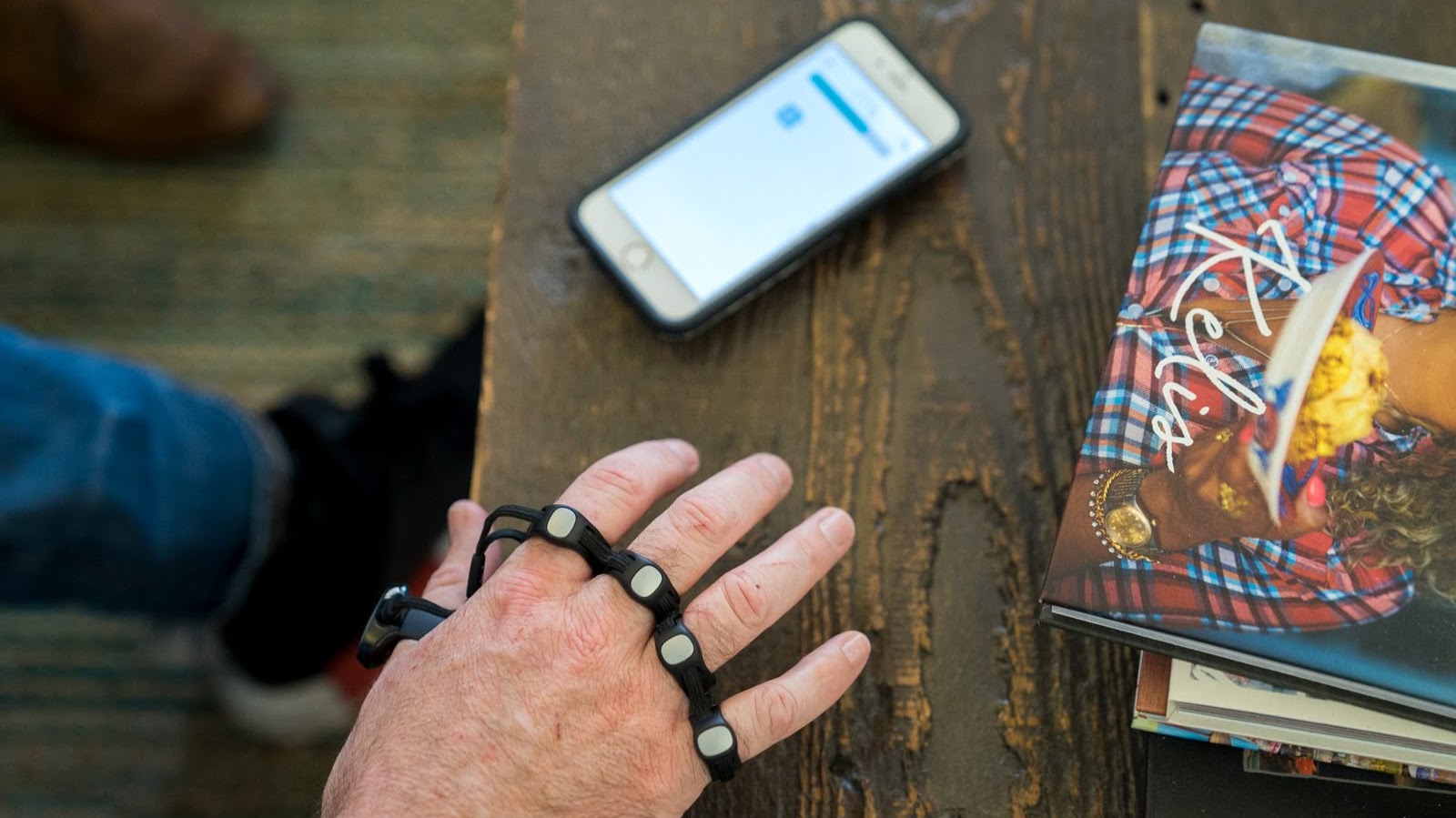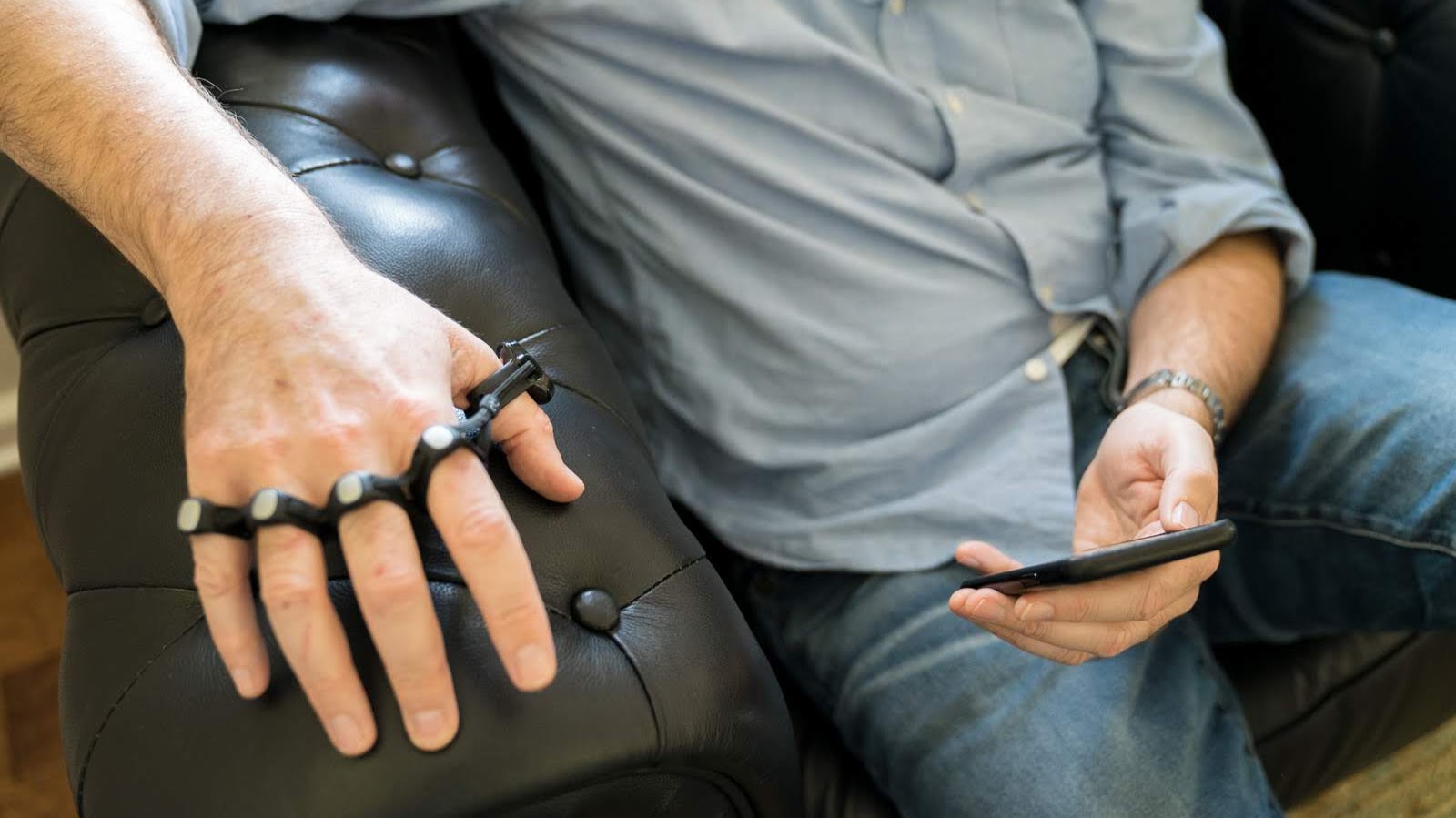The success of augmented reality means it may be time to rethink the way we type

The latest generation of virtual and augmented reality headsets (like the HoloLens 2 unveiled by Microsoft at MWC 2019) offer hand-tracking and voice controls, but there's one task they still can't handle easily: typing.
That's where Tap comes in. It's a device that resembles a silicone knuckle duster, but is in fact a wearable keyboard that lets you type one-handed without having to use a desk. We caught up with Dovid Schick, Tap's creator, at MWC to find out how it works, and what it means for the future of typing.
At your fingertips
Tap is a set of connected silicone rings, which fit snugly onto the fingers of your dominant hand and are adjusted using nylon sliders on the palm side. The thumb ring bears the power button, plus a flat edge that serves as a mouse, letting you scroll around webpages and documents by sliding it across any surface.
To type, you just tap your fingers against whatever comes to hand. That could be a table, the arm of a chair, the back of your other hand, your sleeve – anything hard enough to stop your fingers moving. Different combinations of fingers produce different letters, and with practice, you can expect to tap away at over 50wpm single-handed.
When we tried it, it felt snug but comfortable (it's available in two sizes, but there's some overlap between them). We tested it by tapping on a table, and found that it wasn't necessary to bring down our fingertips hard at all. A light touch is all it takes, and you can use it while sitting back comfortably rather than being tempted to hunch over, as you might while using a keyboard.
It's not a brand new device, and has been on sale since 2018, but Schick (an electrical engineer by trade, who developed the first digital X-ray system for dentists in the 1990s) believes this is Tap's time to shine.

"It’s become clear that there are certain segments that are better suited [to Tap]," he explains. "The killer application in the long term I believe is wearable screens. Once you’re wearing a screen you're not going to be carrying a keyboard."
Sign up for breaking news, reviews, opinion, top tech deals, and more.
Speech recognition is one way around this problem, but as Schick notes, it's not always practical – particularly in noisy environments like manufacturing plants and server rooms, where AR is particularly helpful, or in situations where colleagues will find constant chatter annoying.
He says that members of the blind community also find Tap helpful because, unlike touchscreens, which offer no haptic feedback, typing with Tap is a very tactile experience.
"You might think that blind people would be really early adopters of speech technology," he says, "but their adoption rates are about the same as sighted people [one in five], for the same reasons and because they don’t really feel comfortable walking around talking."
How to tap
Among sighted home users, Tap's main appeal is its convenience, together with its strangeness. "It's forward-looking, and a lot of people like that," Schick says. However, once you know the basics, it's surprisingly easy to use.
The device comes with two training apps. The first of these, Tap Genius, introduces the taps for each letter of the alphabet, plus basic punctuation. The vowels are the simplest, and each is represented by a single tap with one of your fingers. Other letters are a little more complex, requiring two, three or four fingers. The trickiest is J, which is created by tapping every finger except your ring finger, but can also be typed by double-tapping your middle finger.
Once you've mastered the letters, you'll be able to type, but you'll be slow. To build muscle memory, you need the second app, Tap Academy. This app provides a course of 10-20 minute lessons, designed to be completed over 30 days. By the end, you should be tapping away like a pro.
"Many people don't finish the course," Schick says. "The course goes for 30 days, but most people reach proficiency speeds in between 15 and 21 days."
Your next keyboard?
Although not all of the 300 businesses testing Tap also use augmented reality, Schick says that many of them do – and it's easy to understand why.
"AR has essentially shifted in the last couple of years from consumer-focused to enterprise-focused," he says. They’re trying to really build practical business solutions for people who want an always-on display and have to be able to use their hands. It allows them to do discrete, very quick input in any environment.

"They use voice quite a bit," he adds. "Voice is our main rival, and is very good for people who speak a well-articulated and unaccented version of whichever language they're in, but that's not everyone."
With Microsoft opening an app store for HoloLens 2, and partnering with companies like Mozilla to create web browsers specifically for augmented reality, it looks like there could be a real need for a device that lets users type without looking, or using a desk. It might look strange now, but Tap's set of silicone rings could be your next keyboard.
MWC (Mobile World Congress) is the world's largest showcase for the mobile industry, stuffed full of the newest phones, tablets, wearables and more. TechRadar is reporting live from Barcelona all week to bring you the very latest from the show floor. Head to our dedicated MWC 2019 hub to see all the new releases, along with TechRadar's world-class analysis and buying advice about your next phone.

Cat is TechRadar's Homes Editor specializing in kitchen appliances and smart home technology. She's been a tech journalist for 15 years, having worked on print magazines including PC Plus and PC Format, and is a Speciality Coffee Association (SCA) certified barista. Whether you want to invest in some smart lights or pick up a new espresso machine, she's the right person to help.